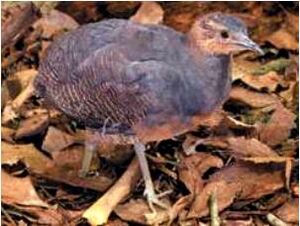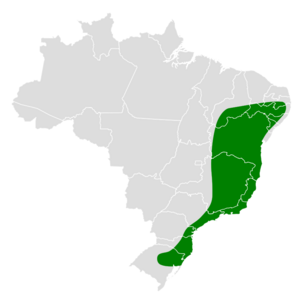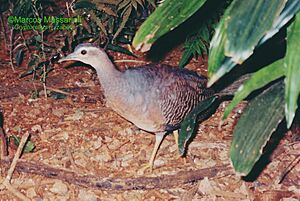Yellow-legged tinamou facts for kids
Quick facts for kids Yellow-legged tinamou |
|
|---|---|
 |
|
| Crypturellus n. noctivagus | |
| Conservation status | |
| Scientific classification | |
| Genus: |
Crypturellus
|
| Species: |
noctivagus
|
| Subspecies | |
|
C. n. noctivagus |
|
 |
|
The yellow-legged tinamou (Crypturellus noctivagus) is a type of bird that lives in eastern Brazil. You can find it in forests and areas with lots of bushes. This bird looks a bit like a quail and has grey-brown feathers. There are two main types, or subspecies, of this bird. Sadly, its numbers have gone down because of human activities. Because of this, it is listed as Near Threatened by the IUCN.
Contents
Different Types and Where They Live
This bird has two main types, called subspecies:
- C. n. noctivagus: This type lives in southeastern Brazil. You can find it in states like Minas Gerais, Bahia, Espírito Santo, Rio de Janeiro, São Paulo, Paraná, Santa Catarina, and Rio Grande do Sul.
- C. n. zabele: This type lives in northeastern Brazil. It can be found from northern Minas Gerais and Bahia all the way to Paraíba and Piauí.
What They Look Like
The yellow-legged tinamou is about 28 to 31 centimeters (11 to 12 inches) long. Its back is grey, and its lower back and wings have black stripes. Its neck and upper chest are greyish. The lower chest is a reddish-brown color, and its belly is whitish.
It has a black cap on its head and a light yellow stripe above its eye. The stripe above the eye is wider and easier to see in the zabele type. This type is also lighter in color overall. It has a whiter throat and brighter yellow legs compared to the other type.
What They Eat and How They Live
Like other tinamous, the yellow-legged tinamou eats fruit. They find fruit on the ground or on low bushes. They also eat small amounts of invertebrates (like insects), flower buds, soft leaves, seeds, and roots.
When it's time to have babies, the male tinamou takes care of the eggs. These eggs might come from as many as four different females! The male bird sits on the eggs until they hatch. Then, he raises the young birds until they are ready to live on their own, which usually takes about 2 to 3 weeks. The nest is built on the ground, often hidden in thick bushes or between large tree roots.
Where They Live
The yellow-legged tinamou prefers to live in humid forests. However, the zabele type can also be found in drier wooded areas. These include places like savanna-woodland and a special type of forest called Caatinga. They usually live at elevations of 700 meters (2,300 feet) or less.
Protecting the Yellow-Legged Tinamou
The yellow-legged tinamou is facing challenges. Its home is being destroyed, and it is also hunted. Even though its numbers are going down, they are not yet at a critical level. This is why the IUCN lists it as Near Threatened. The area where it lives covers about 1,470,000 square kilometers (568,000 square miles). However, there haven't been many recent sightings in some parts of its old home. It seems to have disappeared from Rio de Janeiro state.



